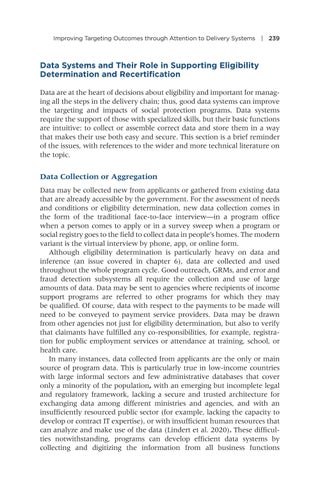Improving Targeting Outcomes through Attention to Delivery Systems | 239
Data Systems and Their Role in Supporting Eligibility Determination and Recertification Data are at the heart of decisions about eligibility and important for managing all the steps in the delivery chain; thus, good data systems can improve the targeting and impacts of social protection programs. Data systems require the support of those with specialized skills, but their basic functions are intuitive: to collect or assemble correct data and store them in a way that makes their use both easy and secure. This section is a brief reminder of the issues, with references to the wider and more technical literature on the topic.
Data Collection or Aggregation Data may be collected new from applicants or gathered from existing data that are already accessible by the government. For the assessment of needs and conditions or eligibility determination, new data collection comes in the form of the traditional face-to-face interview—in a program office when a person comes to apply or in a survey sweep when a program or social registry goes to the field to collect data in people’s homes. The modern variant is the virtual interview by phone, app, or online form. Although eligibility determination is particularly heavy on data and inference (an issue covered in chapter 6), data are collected and used throughout the whole program cycle. Good outreach, GRMs, and error and fraud detection subsystems all require the collection and use of large amounts of data. Data may be sent to agencies where recipients of income support programs are referred to other programs for which they may be qualified. Of course, data with respect to the payments to be made will need to be conveyed to payment service providers. Data may be drawn from other agencies not just for eligibility determination, but also to verify that claimants have fulfilled any co-responsibilities, for example, registration for public employment services or attendance at training, school, or health care. In many instances, data collected from applicants are the only or main source of program data. This is particularly true in low-income countries with large informal sectors and few administrative databases that cover only a minority of the population, with an emerging but incomplete legal and regulatory framework, lacking a secure and trusted architecture for exchanging data among different ministries and agencies, and with an insufficiently resourced public sector (for example, lacking the capacity to develop or contract IT expertise), or with insufficient human resources that can analyze and make use of the data (Lindert et al. 2020). These difficulties notwithstanding, programs can develop efficient data systems by collecting and digitizing the information from all business functions


